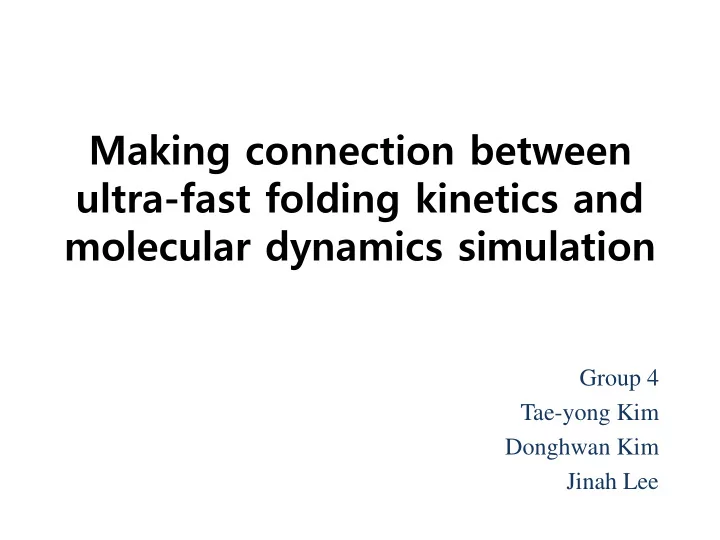

Making connection between ultra-fast folding kinetics and molecular dynamics simulation Group 4 Tae-yong Kim Donghwan Kim Jinah Lee
Concept pts of pr protein in fold ldin ing Protein folding is essential for understanding biological processes and developing therapeutic approaches to misfolding-related diseases. Protein folding can be followed in equilibrium experiments, which monitor protein states as a function of temperature or denaturant concentration, and kinetics
Un Unfold ldin ing/fold ldin ing ex exper erimen ents Image of mass spectroscopy Mass spectrometry : effective tool for supporting both thermodynamic and kinetic protein-folding studies: in microseconds or even more Fast photochemical oxidation of proteins(FPOP): combined rapid mixing with a chemical approach, FPOP, to afford potentially a considerably higher resolution probe of folding.
Tem emper erature-jumped method Temperature jump is a technique used in the study of chemical kinetics. TJ measurement Example of TJ mehtod Biochem. J. (2001) 358, 165-173
Ult Ultrafast fold ldin ing Proteins that fold on a microsecond timescale. Small single domain proteins, containing less than 100 amino acid residues. Simple folding mechanism. PNAS, 2003, Vol. 100, no.26
villin illin hea eadpiec ece e subdom omain, HP35( 35(His27) 27) HP35 is one of the smallest naturally occurring protein domains. Sequence : LSDED FKAVF GMTRS AFANL PLWKQ QNLKK EKGLF Trp23 is the fluorescence probe; His27 replaces Asn27 of the wild-type sequence, and when protonated. reduces the fluorescence of Trp23 upon folding; Lys24 and Lys29 make repulsive electrostatic interactions with protonated His27 and Arg14, respectively.
TJ TJ wit ith tryptophan f fluorescence det etection Tryptophan quantum yield ( ϕ ) as a function of time at 10 ° C after a 5 K laser- induced T-jump for 300 μM solutions of Cys-HP35(Nle24,His27,Nle29) containing 20 mM sodium acetate, 1 mM TCEP, and either (A) 2.25 M GdmCl (blue) (B) 4 M GdmCl (green) (C) 6 M GdmCl (red) The circles are the experimental data and the lines are fits with a single exponential function.
Kin inetic ics: T Tryptophan T Trip iple let Lif ifetim ime The population of the tryptophan triplet state was monitored by triplet-triplet absorption at 440 nm Normalized tryptophan triplet–triplet absorbance at 440 nm as a function of time on a log scale at 10 ° C for 100 μM solutions of Cys- HP35(Nle24,Nle29) containing 20 mM sodium acetate, 1 mM TCEP, and 2.25 M GdmCl (blue) 4.5 M GdmCl (green) 6 M GdmCl (red) The absorbance is proportional to the sum of the populations of the triplet state in the folded and unfolded states. The circles are the experimental data and the lines are the fits with the kinetic model.
Kin inetic ic m model f l for t trip iple let-lif lifetim ime Triplet-triplet absorbances, A(t)/A(0), with the initial conditions (t=0) * k * k = = f u p ( 0 ) , p ( 0 ) + + F * U * * * * * k k k k f u f u is + p ( t ) p ( t ) = = − λ + − − λ F * U * ( ) / ( 0 ) exp( ) ( 1 ) exp( ) A t A a t a t + − + p ( 0 ) p ( 0 ) F * U * where 1 λ = ± − 2 ( k k 4 Q ) ± 2 = + + + * * k k k 2 k k u f s q = + + + ( ) * * dp Q ( k k )( k k ) k k = − + + * * u s s q f s F * k k p k p s U F * f U * dt − λ + + − λ * * ( k )( k k k ) − + = s u f s ( ) a dp + λ − λ = − + + * * * * ( k k )( ) U * k p k k k p + − u f u F * s q f U * dt
Com omparison on o of fol olding rate Folding times obtained in a two-state analysis of the results from the two methods at denaturant concentrations varying from 1.5–6.0 M guanidinium chloride are in excellent agreement, with an average difference of only 20%. Polynomial extrapolation of all the data to zero denaturant yields a folding time of 220 (+100, − 70) ns at 283 K, suggesting that under these conditions the barrier Comparison of folding times measured between folded and unfolded states has by temperature jump and tryptophan effectively disappeared—the so-called triplet lifetime at 283 K. “downhill scenario.”
Conclu lusio ion & D Dis iscussio ion In this study, we confirmed ultra-fast folding protein time using triplet lifetime experiment. For the future, we would better think about protein that bigger and having more complex mechanism than ultra-fast folding protein to folding rate.
Recommend
More recommend